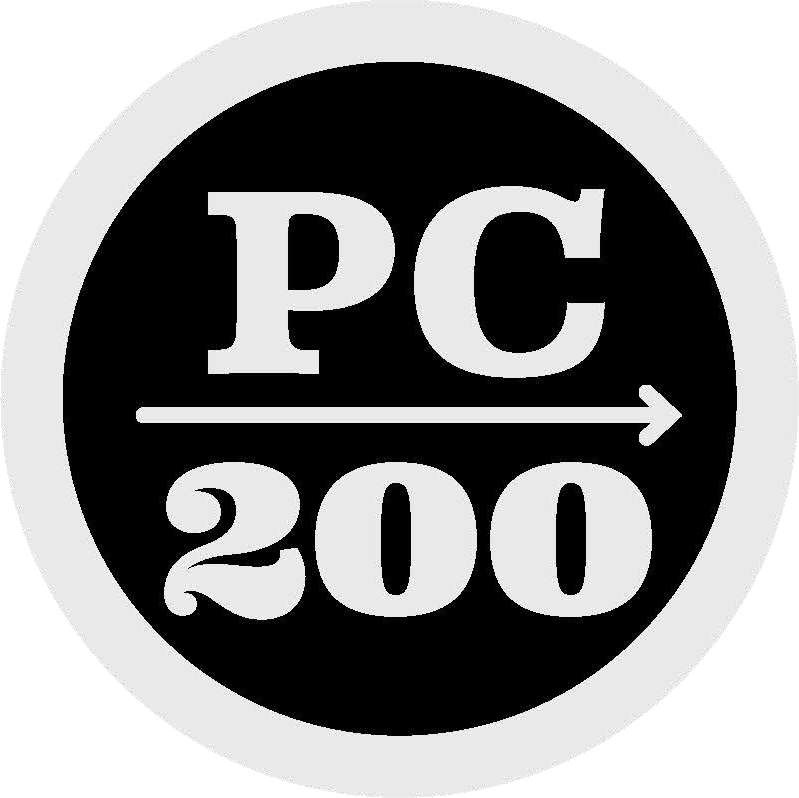I. “Perfect storm” in higher education
A perfect storm appears to be looming in higher education, the result of unparalleled economic pressures and demographic shifts. Skyrocketing costs and student debt, along with the disappearing middle class, are raising serious doubts about the long-term health and viability of colleges and universities: record numbers of institutions have closed in the past 25 years, with several hundred under watch by regulators due to financial issues. At the same time, undergraduate enrollments are stagnating across the country and expected to steadily decline in the Northeast, especially among the groups that have traditionally served as the “bread and butter” for colleges and universities – white middle and upper class students.
In response to these threats, many institutions are exploring alternate forms of revenue through continuing, professional, and/or graduate education programs. Schools are introducing and investing in alternative programs and delivery formats – such as graduate degrees, certificates or other “microcredentials,” and/or online programs.
The Washington Post (2017) recently reported that institutions can no longer simply raise tuition to make up for declining enrollments or higher costs, compelling them to “scramble for other revenue.” Quoting Rick Beyer, managing principal of AGB Institutional Strategies, part of the Association of Governing Boards of Universities and Colleges, representing boards of regents and trustees, “Probably the most important issue that all institutions face, large and small, is that they no longer can pass on their rising costs to the consumer.”
The article continues, “Squeezed by budget cuts, an enrollment decline and consumer resistance to continued increases in tuition, colleges and universities are hunting for new moneymaking ventures . . . As slow as some are being to take up these ideas, institutions seem to have little choice but to diversify their incomes. No matter how fast tuition keeps going up, they’re giving back more and more of it in the form of discounts. Forty-nine cents of every dollar from tuition goes back out the door as financial aid to lure students, up from 38 cents a decade ago, the National Association of College and University Business Officers reports.“
II. Alternative Revenue Sources
Several institutions are turning to the continuing/professional/graduate education landscape to pursue these alternative sources of revenue.
According to the Hanover Research Industry Trend Report (2017), over 50% of their higher education projects in the past year focused on the creation or review of academic programs. Programs of common interest were the Master of Social Work (MSW); Bachelor, Master, and Doctor of Nursing (BSN, MSN, DNP); and the Bachelor and Master of Nutrition/Food Science (BS, MS). Furthermore, the report goes on to state: “Nearly 1 in 5 New Program Development projects either focused specifically on identifying high-demand programs that could be delivered in online formats, or included investigations of traditional, distance, and blended offerings.” See Appendix I for Hanover’s list of “High Growth” programs for 2017.
A. Graduate Degrees: According to research by the Education Advisory Board (EAB, 2015), master’s degrees are expected to grow faster than degrees at any other level over the next decade. By 2022, they are predicted to account for nearly a third of all degrees awarded.
“The fastest rates of growth in master’s degrees across the next decade will take place outside the fields that currently dominate enrollments [business, law, education, and health care] . . . Instead, the fastest growth lies in niche programs that are customized to new and rapidly changing roles, such as cybersecurity, data analytics, and health informatics. These programs are commonly housed outside the major professional schools and tend to cross traditional fields and disciplines.”
The emerging graduate education market is “micro-targeted” for different working professional audiences — career starters, career advancers, career changers, and career crossers – and tailored to student preferences and needs. “Hallmarks of successful, programs include flexible delivery, stackable credentials, practical experience, accelerated format, interdisciplinary pathways, and professional development.”
Please refer to Appendix II for further examples of these niche master’s programs.
According to EAB research (2015), several institutions are also introducing 4+1 and 3+2 combined undergraduate/graduate programs in order to remain competitive, generate additional revenue, and enhance employment opportunities for students. A list of sample programs at private colleges and universities is provided in Appendix III. A potential program for Providence College to consider would be a 4+1, BA/MSW program in Social Work.
B. Online: Many institutions are developing online degrees in order to capitalize on the market for online learning that continues to grow, despite the decline in overall higher education enrollments. According to the Distance Education Enrollment Report (2017), the number of higher education students taking at least one distance education course exceeded six million in 2015. Almost 30% of students were taking at least one distance education course (a total of 6,022,105 students). The increase of 226,375 distance education students represents a 3.9% increase over the previous two years.
C. Certificates and Other Credentials: The market for certificates and other “microcredentials” – versus degrees — has been rapidly expanding, creating new opportunities for higher education (along with for-profits and start-ups).
A recent Hechinger Report (2017) states that the bachelor’s degree is no longer sufficient preparation for the workplace, and raises the questions: “Could credentials replace traditional education? Do we need college?” The article reports that half of recent college graduates are not using skills they learned in college at work, and that 86% are learning new professional skills outside of college. They are seeking just-in-time, modular learning.
“Everyone wants more modular chunks,” said Anant Agarwal, the CEO of edX, which recently launched its MicroMasters program for that reason. Many people, he said, don’t want to spend time or money on traditional master’s degrees, preferring groups of skills they can use right away, such as business analytics or digital marketing. The job culture, he said, “is moving to smaller and smaller credentials and continuous education.”
The trend in professional education is toward certificates and stackable credentials, which can be mixed and matched; added on to later; and/or applied toward a master’s degree – or not. Areas of study tend to be highly specialized, in niche areas such as “NCAA Compliance.”
There are many reasons why the trend toward shorter, bite-sized professional education is particularly strong among millennials – who will make up 75% of the workforce by 2025. Over 50% of this population find themselves in leadership positions with very little training and preparation. In addition, they are expected to hold at least 20 jobs over their lives (EAB Presentation, 2017). This means they have little time to grow into a job and lack job loyalty. Short-term, flexible professional education is therefore in demand.
References
Allen, I. Elaine and Seaman, Jeff. (2017). Digital Learning Compass: Distance Education Report. Babson Survey Research Group, e-Literate, and WCET.
The Advisory Board Company. (2015). “Understanding the Changing Market for Professional Master’s Programs.”
The Advisory Board Company. (2015). “4+1 and 3+2 Programs: Program Creation, Implementation, and Assessment.”
Carlson, Scott. “The future of work.” The Chronicle of Higher Education (2017).
Deming, David J. The growing importance of social skills in the labor market. No. w21473. National Bureau of Economic Research, 2015.
Hanover Research 2017 Industry Trend Report. Available at: http://www.hanoverresearch.com/
Hickman, Carla. “Higher Ed in the New Learning Economy.” EAB Presentation, Providence, RI, March 27, 2017.
Job Outlook Survey. The National Association of Colleges and Employers (2016). Available at: https://www.naceweb.org/career-development/trends-and-predictions/job-outlook-2016-attributes-employers-want-to-see-on-new-college-graduates-resumes/
Marcus, Jon. “Under pressure to contain tuition, colleges scramble for other revenue.” The Washington Post. May 1, 2017. Available at: https://www.washingtonpost.com/news/grade-point/wp/2017/05/01/under-pressure-to-contain-tuition-colleges-scramble-for-other-revenue/?utm_term=.a99e91cc1369
Pappano, Laura. “Is the college degree outdated? How small-bite credentials may trump college learning.” The Hechinger Report. (April 27, 2017). Available at: http://hechingerreport.org/college-degree-outdated/
World Economic Forum. “Employment, Skills and Workforce Strategy for the Fourth Industrial Revolution.” World Economic Forum, Geneva, Switzerland, 2016.
World Economic Forum. “What will digitalization do to the future?” World Economic Forum, Geneva, Switzerland, 2015.
Appendix I: Hanover’s New Program Opportunities
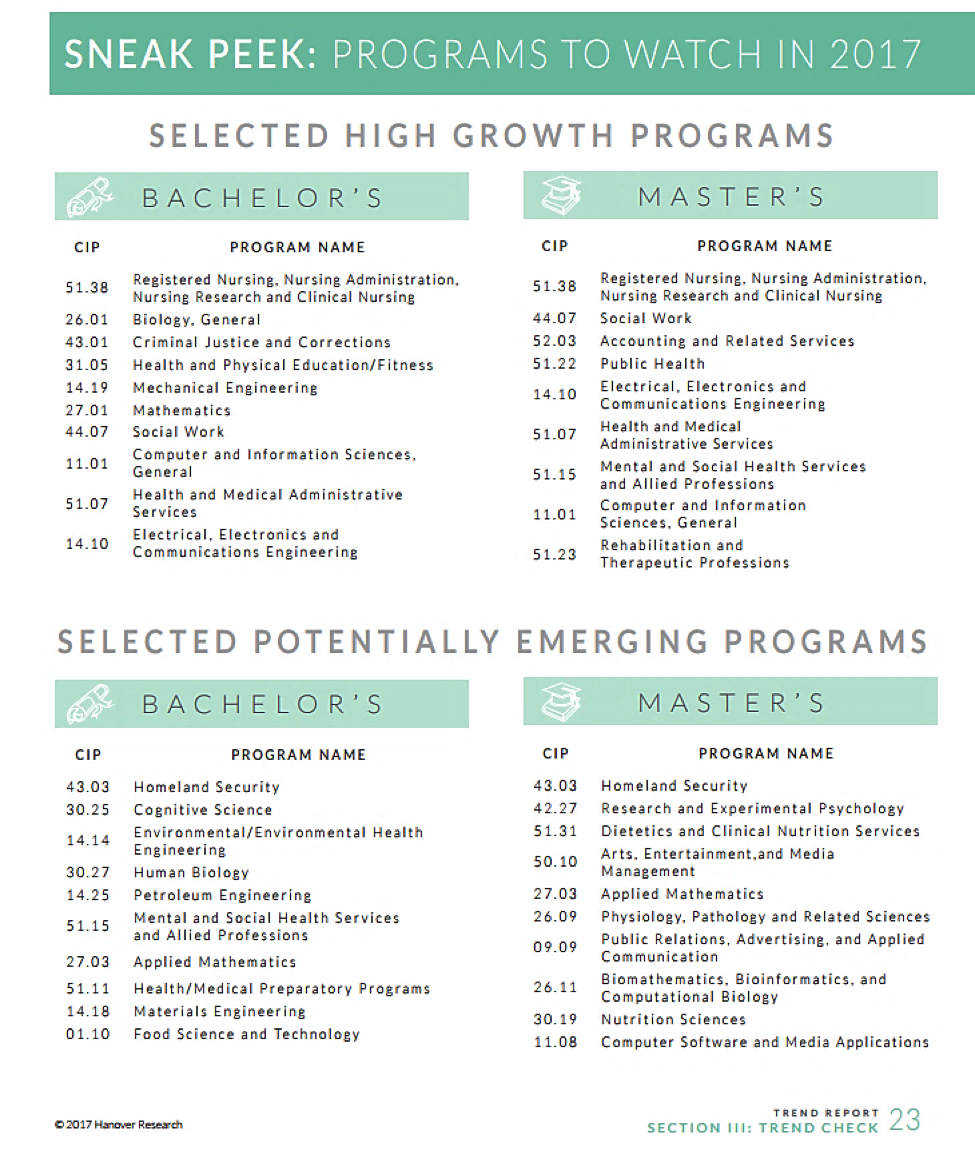
Appendix II: Niche Master’s Programs (EAB)
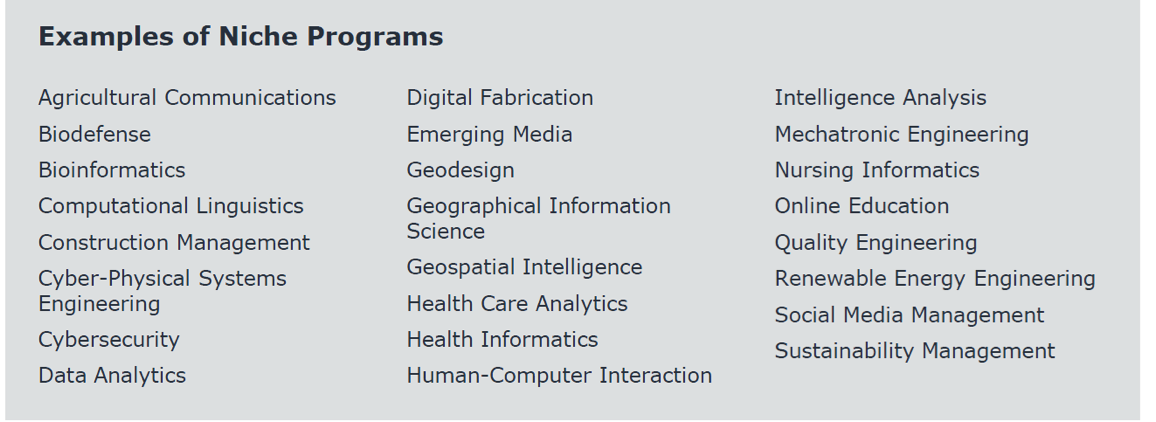
Appendix III: Sample 4+1 and 3+2 Programs
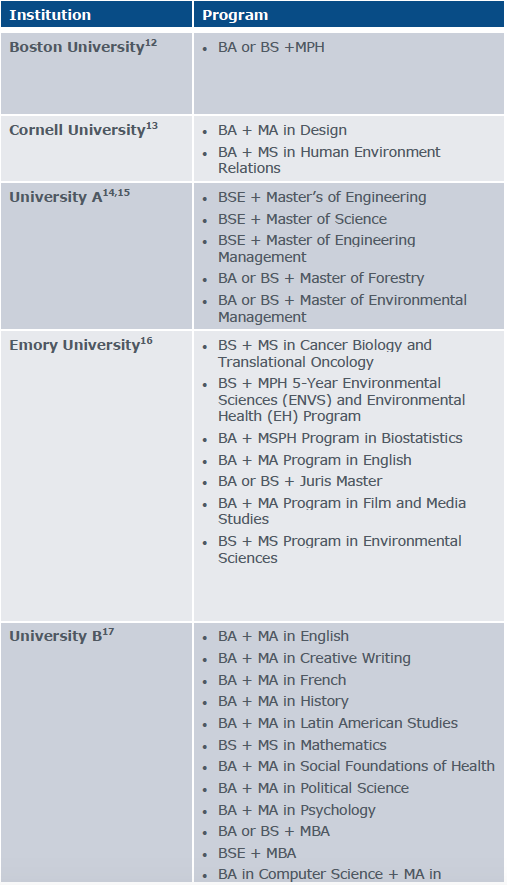
13) “Dual Degree and 4+1 Programs,” Boston University School of Public Health, accessed August 27th, 2015, http://www.bu.edu/sph/students/resources/courses-and-academic-resources/guides/2014-2015-concentrators-guides/dual-degree-4-1-programs/.
14) “Design and Environmental Analysis,” Cornell University College of Human Ecology, accessed August 27th, 2015, http://www.human.cornell.edu/dea/graduate/five.cfm.
15) “4+1 BSE + Master’s Program,” Pratt School of Engineering, accessed August 10th, 2015, http://pratt.duke.edu/undergrad/degree-programs/bse-masters.
16) “Cooperative College (3+2) Program,” Duke Environment, accessed August 27th, 2015, https://nicholas.duke.edu/programs/masters/3-2.
17) “Current 4+1 Programs, Emory University College of Arts and Sciences,” accessed August 27th, 2015, http://catalog.college.emory.edu/department-program/four-one-programs/index.html.
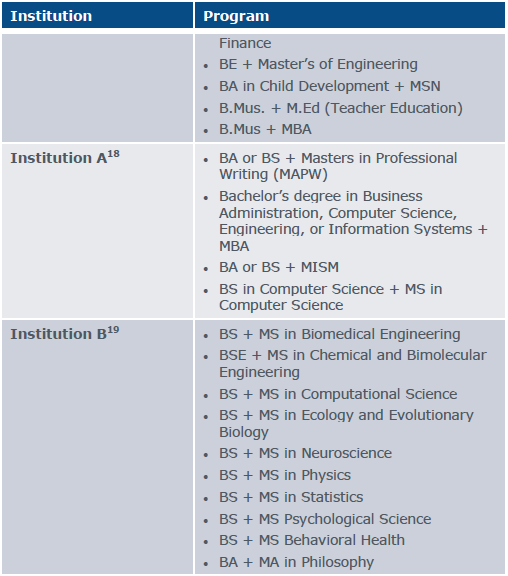
18) “Joint Undergraduate/Graduate Programs,” Academics, accessed August 10th, 2015. http://admissions.vanderbilt.edu/vandybloggers/2012/03/joint-undergraduategraduate-programs/.
